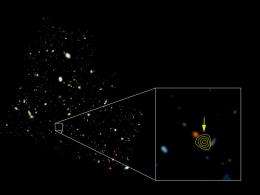June 14, 2012 report
After ten years of trying, researchers measure distance to starburst galaxy HDF 850.1
![[C II] line emission towards HDF 850.1. Image: Nature doi:10.1038/nature11073 After ten years of trying, researchers measure distance to starburst galaxy HDF 850.1](https://scx1.b-cdn.net/csz/news/800a/2012/aftertenyear.jpg)
(Phys.org) -- Back in 1998, researchers studying submillimeter light emissions in the Hubble Deep Field (long exposures of a portion of the sky taken by Hubble in 1995) discovered something really bright, a galaxy that appeared to be producing stars at an unprecedented rate. Unfortunately, scientists weren’t able to figure out how far away it was, which led a few years later to various attempts to measure it, all to no avail. Now, nearly ten years after the effort began, a research team is reporting in their paper published in the journal Nature that they have finally met with success and have found that starburst galaxy HDF 850.1 is 12.6 billion light years away from us.
The reason the galaxy wasn't detected by Hubble is because the famous orbiting telescope records ordinary light, which in this case couldn’t reveal the galaxy because it is shrouded in clouds of gas and dust. But because submillimeter light has longer wavelengths, it can be seen just fine here on Earth when the right technology is used. When it was first spotted, researchers were surprised by how bright it was, which past experience has shown implies that it must be spawning new stars at an incredible rate. Subsequent research revealed that the starburst galaxy was producing stars at a rate of 850 per year, a thousand times as many as are formed in our own Milky Way galaxy.

But its distance from us remained a mystery until this new team tried a technique based on the light given off by molecular gases when new stars are formed. Faraway galaxy distances can be measured using the Dopler shift, the change in the frequency of light waves as an object moves farther away from us, which is what’s happening in space due to the expansion of the universe. To measure HDF 850.1's distance, the researchers calculated its “redshift” at 5.2, which allowed them to calculate its distance from us and because it’s over twelve and a half billion light years away, that means the light we see today coming from HDF850.1 was emitted just 1.1 billion years after the moment when the Big Bang is believed to have occurred.
Still a mystery is why the galaxy is forming so many stars, the current theory is that it’s due to two galaxies colliding, thus new research will focus on trying to find out if that is the case with HDF 850.1.
More information: The intense starburst HDF 850.1 in a galaxy overdensity at z ≈ 5.2 in the Hubble Deep Field, Nature 486, 233–236 (14 June 2012) doi:10.1038/nature11073
The Hubble Deep Field provides one of the deepest multiwavelength views of the distant Universe and has led to the detection of thousands of galaxies seen throughout cosmic time1. An early map of the Hubble Deep Field at a wavelength of 850 micrometres, which is sensitive to dust emission powered by star formation, revealed the brightest source in the field, dubbed HDF 850.1 (ref. 2). For more than a decade, and despite significant efforts, no counterpart was found at shorter wavelengths, and it was not possible to determine its redshift, size or mass3, 4, 5, 6, 7. Here we report a redshift of z = 5.183 for HDF 850.1, from a millimetre-wave molecular line scan. This places HDF 850.1 in a galaxy overdensity at z ≈ 5.2, corresponding to a cosmic age of only 1.1 billion years after the Big Bang. This redshift is significantly higher than earlier estimates3, 4, 6, 8 and higher than those of most of the hundreds of submillimetre-bright galaxies identified so far. The source has a star-formation rate of 850 solar masses per year and is spatially resolved on scales of 5 kiloparsecs, with an implied dynamical mass of about 1.3 × 1011 solar masses, a significant fraction of which is present in the form of molecular gas. Despite our accurate determination of redshift and position, a counterpart emitting starlight remains elusive.
Journal information: Nature
© 2012 Phys.Org


















